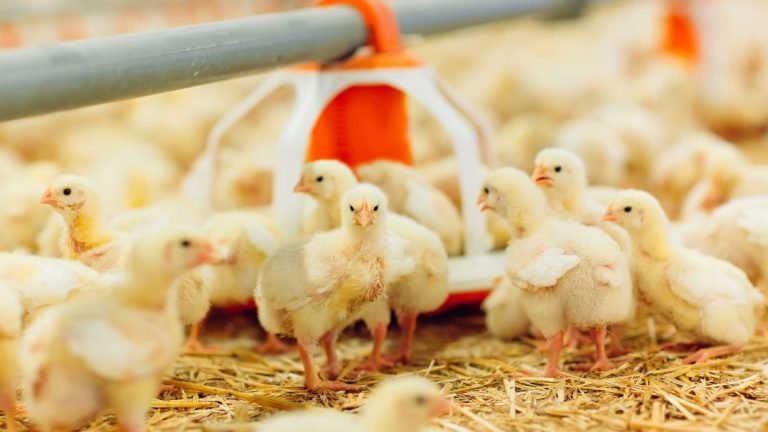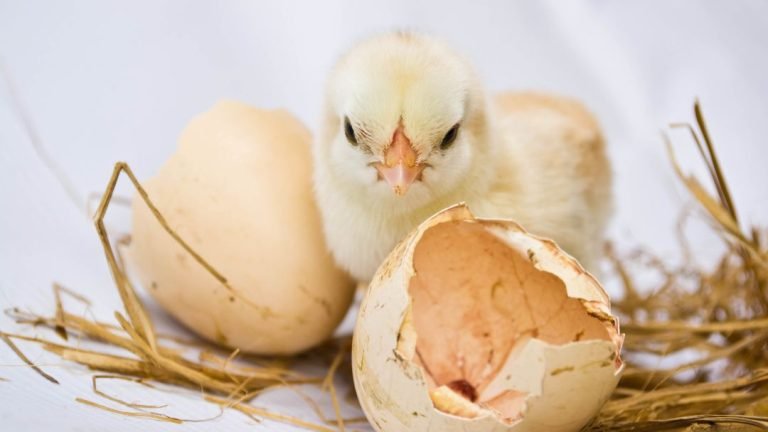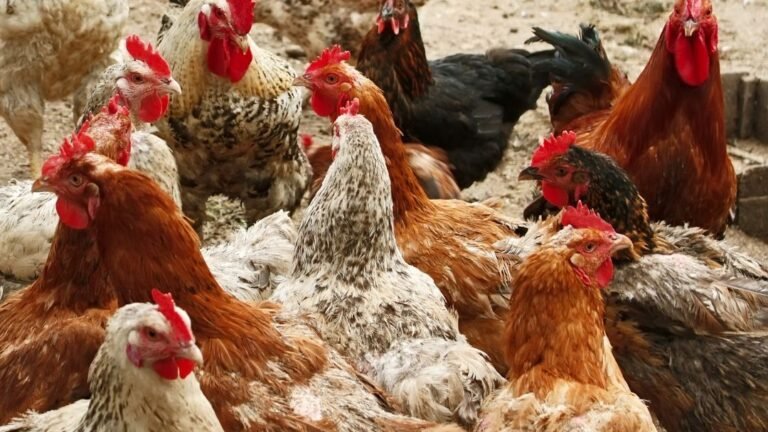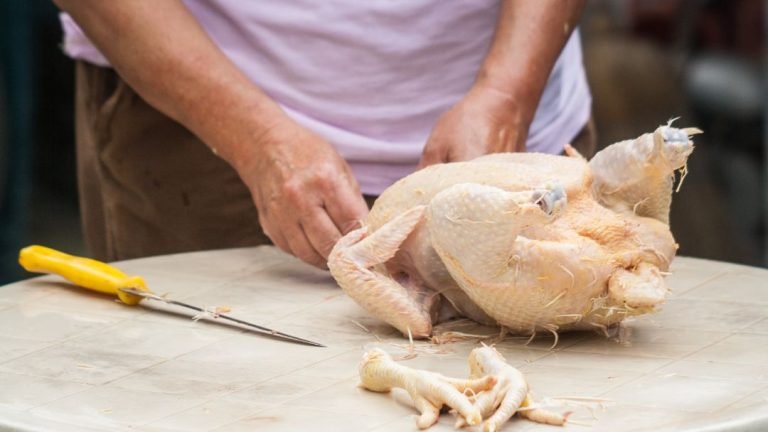Ten popular chicken breeds that lay colored eggs are Ameraucana (blue), Easter Egger (various), Olive Egger (olive green), Marans (dark brown), Welsummer (dark brown), Araucana (blue), Cream Legbar (blue), Barnevelder (dark brown), Penedesenca (dark brown), and Favaucana (light green). Chickens come in various colors and sizes, making them a popular choice for backyard farmers and hobbyists.
The allure of colored eggs adds a fun and unique touch to egg collecting and can be a great conversation starter. We will explore these 10 chicken breeds and provide a color chart to help you choose the perfect addition to your flock.
The Fascinating World Of Chicken Breeds
When it comes to chicken breeds, there is a fascinating world just waiting to be explored. From different physical attributes to varying egg colors, each breed has its unique features that make it stand out. In this blog post, we will delve into the world of chicken breeds that lay colored eggs, showcasing 10 popular breeds and providing a helpful color chart. But first, let’s understand how to differentiate chicken breeds based on egg color and explore the factors that influence the colors of these remarkable eggs.
Differentiating Chicken Breeds Based On Egg Color
One interesting aspect of chicken breeds is the wide range of egg colors they produce. By understanding the differences in egg color, you can identify the breed of your chicken simply by the eggs they lay. Here are some key characteristics to look out for:
- Shell color: Chicken eggshells can come in various shades, including white, cream, brown, and even blue or green.
- Consistency: The thickness and texture of the eggshell can vary, with some breeds having a smooth shell while others have a rough or speckled surface.
- Size: Different breeds lay eggs of varying sizes, from small to jumbo.
By closely examining these factors, you can differentiate chicken breeds based on egg color alone. Now, let’s explore the factors that influence the mesmerizing array of colors you can find in chicken eggs.
Factors Influencing Egg Color
The stunning array of colors seen in chicken eggs is a result of various factors. Understanding these factors can shed light on why some breeds produce eggs with specific hues. Here are the main determinants of egg color:
- Breed genetics: Egg color is primarily influenced by the genetics of the chicken breed. Different breeds have different pigments that contribute to the colors they produce.
- Dietary factors: The diet of a chicken plays a role in the intensity and richness of the egg color. Certain nutrients, such as carotenoids, can enhance the pigmentation during the egg-laying process.
- Age of the hen: As a hen ages, her eggs may change in color. This is particularly noticeable in breeds that lay darker eggs, as the color may become more pronounced over time.
- Housing conditions: Environmental factors can also impact the appearance of egg color. Chickens raised in certain conditions, such as free-range or pasture-raised, may produce eggs with colors influenced by exposure to sunlight or certain natural elements.
By considering these factors, you can appreciate the intricate process that determines the captivating colors of chicken eggs. Now that we have explored the differentiation of chicken breeds based on egg color and the factors that influence these colors, let’s move on to unveiling the 10 popular breeds known for their colored eggs.
Blue Egg Layers: A Unique Addition To Your Flock
When it comes to raising chickens, there’s nothing quite as intriguing as finding eggs in colors other than the traditional white or brown. If you’re looking to add a touch of uniqueness to your flock, blue egg layers are the perfect choice. These breeds not only lay eggs with shells in shades of blue, but they also possess other appealing characteristics that make them a favorite among poultry enthusiasts. In this article, we’ll explore the characteristics of blue egg layers and introduce you to some popular chicken breeds that lay blue eggs.
Characteristics Of Blue Egg Layers
Blue egg layers exhibit a range of characteristics that set them apart from other chicken breeds. Here are some notable traits:
- Shell Color: The most obvious characteristic of blue egg layers is the color of their eggshells. Rather than the conventional white or brown, these hens lay eggs with shells ranging from light blue to a striking sky blue.
- Genetics: Blue eggshell color is a result of a genetic trait known as oocyanin. However, the shade of blue can vary depending on the breed and individual hen.
- Temperament: Blue egg layers are generally known for their friendly and docile nature, making them great additions to a backyard flock. They are usually calm, gentle, and well-suited for families with children.
- Hardiness: Many blue egg layers are known for their ability to thrive in various climates and adapt to different living conditions. Whether you reside in a hot or cold region, these breeds can handle the weather with ease.
- Egg Production: Along with their unique shell color, blue egg layers are known for their steady egg-laying capabilities. While the frequency of egg production may vary, on average, these hens lay around 200 to 250 eggs per year.
Popular Blue Egg Chicken Breeds
If you’re ready to bring some blue eggs into your life, here are some popular blue egg chicken breeds to consider:
| Breed | Eggshell Color | Appearance | Temperament |
|---|---|---|---|
| Araucana | Blue or green | Distinctive pea comb; ear tufts | Gentle and independent |
| Ameraucana | Blue | Muff and beard; tail angle | Active and curious |
| Easter Egger | Various shades of blue, green, or brown | Mixed genetic background | Fun and friendly |
| Cream Legbar | Blue | V-shaped comb; crests in females | Active and sociable |
These are just a few examples of the blue egg layers out there. Each breed has its own unique characteristics and appearance, allowing you to choose the perfect addition to your flock.
Brown Egg Layers: Classic And Reliable Choices
When it comes to selecting chickens that are classic and reliable egg layers, you can’t go wrong with the timeless beauty of brown egg layers. These chickens not only add a rustic charm to your backyard flock, but they also provide you with a steady supply of delicious and nutritious brown eggs. In this article, we will explore the characteristics of brown egg layers and introduce you to some popular breeds that lay these delightful treasures.
Characteristics Of Brown Egg Layers
Brown egg layers are known for their exceptional egg-laying abilities, making them a popular choice among homesteaders and egg enthusiasts alike. Here are the key characteristics that set them apart:
- Reliability: Brown egg layers are highly reliable, consistently producing eggs throughout the year. Whether it’s spring, summer, fall, or winter, these chickens will keep your egg basket filled.
- Steady Production: Unlike some chicken breeds that have sporadic laying patterns, brown egg layers are known for their consistent production. They typically lay an egg almost every day, ensuring you have a steady supply of fresh eggs.
- Hardiness: Brown egg layers are generally resilient and adaptable, able to tolerate a wide range of climates and environmental conditions. This makes them suitable for backyard chicken enthusiasts in various regions.
- Easy Maintenance: Another advantage of brown egg layers is that they are relatively low maintenance. They are often regarded as excellent for beginners due to their docile nature and simple care requirements.
- Egg Size: The eggs produced by brown egg layers come in a range of sizes. From medium to large, these eggs are perfect for a variety of culinary uses and can easily accommodate your baking and cooking needs.
Popular Brown Egg Chicken Breeds
Now that you are familiar with the appealing characteristics of brown egg layers, let’s take a closer look at some of the most popular breeds that lay beautiful brown eggs:
| Breed | Egg Color | Additional Notes |
|---|---|---|
| Rhode Island Red | Brown | A versatile breed known for its hardiness and excellent egg production. |
| Plymouth Rock (Barred Rock) | Brown | A calm and friendly breed with a charming barred feather pattern. |
| Wyandotte | Brown | A dual-purpose breed that is admired for its beautiful plumage and cold-weather tolerance. |
| Australorp | Brown | One of the best brown egg layers, known for its exceptional laying capabilities and gentle nature. |
| Orpington | Brown | A large and friendly breed that lays generous-sized brown eggs. |
These are just a few examples of the popular brown egg chicken breeds available. Each of these breeds brings its own unique characteristics to the table, ensuring that you can find the perfect fit for your flock.
With their classic appearance and dependable egg-laying abilities, brown egg layers are a timeless choice for any backyard chicken enthusiast. Whether you are a beginner or an experienced chicken keeper, these reliable and beautiful chickens will undoubtedly be a valuable addition to your flock.
Green And Olive Egg Layers: Unconventional And Eye-catching
When it comes to chicken eggs, most people are familiar with the traditional colors like white and brown. However, if you’re looking to add a unique and captivating touch to your egg cartons, choosing green and olive egg layers is the way to go. These chickens produce eggs that boast unconventional hues, ranging from subtle sage green to deep olive. In this article, we’ll explore the characteristics of green and olive egg layers and introduce some of the most popular breeds that lay these delightfully colorful eggs.
Characteristics Of Green And Olive Egg Layers
Green and olive egg layers are known for their distinctive egg coloration. Eggs laid by these breeds often feature a range of beautiful shades, the likes of which you won’t find in your average grocery store egg carton. Here are some key characteristics of green and olive egg layers:
- Shell Color: The shells of eggs laid by these chickens can vary from light pastel green to deep olive.
- Consistency: The color of the eggs may vary slightly between breeds and individual chickens, but they generally maintain a consistent green or olive shade.
- Pigmentation: The unique coloration of these eggs is a result of the pigment biliverdin, which is deposited on the eggshell during the laying process.
- Interior Quality: While the exterior of green and olive eggs catches the eye, the interior quality remains the same as any other chicken egg. They are just as delicious and nutritious!
Popular Green And Olive Egg Chicken Breeds
If you’re ready to introduce some unconventional beauty to your flock and egg basket, consider adding one of these popular green and olive egg chicken breeds:
| Breed | Egg Color | Egg Size | Production |
|---|---|---|---|
| Araucana | Olive Green | Medium | Good |
| Americauna | Light Blue/Green | Medium | Excellent |
| Marans | Dark Chocolate Brown/Olive | Large | Good |
| Welsummer | Terra-cotta/Mahogany | Large | Excellent |
| Easter Egger | Various Shades of Green/Blue | Medium/Large | Good |
These breeds offer not only egg color variation but also come with their own unique traits and personalities. Whether you’re an experienced chicken enthusiast or new to raising backyard chickens, any of these breeds would be a fantastic addition to your flock.
Colorful Egg Layers: Bringing Variety To Your Basket
Adding a touch of vibrancy to your daily egg collection is a delightful way to inject some freshness into your routine. Picture this – walking to your chicken coop, opening the nesting boxes, and finding an array of colored eggs waiting for you. Not only are these eggs visually appealing, but each hue also holds its own unique charm and character. In this article, we will explore 10 popular chicken breeds that lay colored eggs, along with a handy color chart to help you identify each shade. Get ready to discover a world of vibrant egg-laying possibilities!
Characteristics Of Colorful Egg Layers
Colorful egg layers come in various shapes, sizes, and personalities. While they all share the common trait of laying eggs with stunning hues, it’s important to note that the intensity of the color may vary among individuals within the same breed. Here are some key characteristics to consider when selecting your own colorful egg layers:
- Breed: Different chicken breeds have their own unique egg colors, ranging from light pastels to deep, rich shades. Each breed has its signature color palette.
- Shell Quality: Colorful egg layers produce eggs with strong and sturdy shells, ensuring they withstand handling and transportation without cracking.
- Egg Size: Egg sizes can vary among breeds, so choose based on your personal preference and usage.
- Temperament: Consider the temperament of the breed as some are more docile and friendly, while others may be more active and independent.
- Climate Adaptability: Some breeds are better suited to specific climates, so make sure to choose one that thrives in your local weather conditions.
Popular Colorful Egg Chicken Breeds
In the realm of colorful egg layers, there are several chicken breeds that have gained popularity for their stunning egg hues. Here are 10 breeds known for their colorful egg-laying abilities:
| Chicken Breed | Egg Color | Egg Size | Temperament |
|---|---|---|---|
| Ameraucana | Blue | Medium | Docile |
| Welsummer | Dark Brown | Large | Friendly |
| Easter Egger | Various | Medium-Large | Varies |
| Marans | Dark Chocolate Brown | Medium-Large | Reserved |
| Barnevelder | Dark Brown | Medium | Gentle |
| Isbar | Various Pastels | Medium | Active |
| Olive Egger | Olive | Medium | Curious |
| Penedesenca | Dark Chocolate Brown | Medium-Large | Confident |
| Polish | White (with occasional tint) | Medium | Playful |
| Sicilian Buttercup | Cream | Medium | Active |
Now that you have a glimpse into the world of colorful egg layers and their distinctive characteristics, you can choose the breeds that best match your preferences. Whether you opt for the elegant blue eggs of the Ameraucana or the rich dark chocolate shades of the Marans, each addition will add a splash of color and excitement to your daily egg collection routine. Get ready to delight in the stunning array of colors that these charming chicken breeds bring to your basket!
Color Chart: An Essential Guide To Egg Colors
Color Chart: An Essential Guide to Egg Colors
Understanding the color chart and interpreting egg colors is crucial for any chicken enthusiast. It not only adds diversity and visual appeal to your egg basket but also helps you identify which chicken breed is responsible for producing those vibrant-colored eggs. In this guide, we will delve into the fascinating world of egg colors and explore a color chart that will become your go-to resource for identifying the breeds behind the hues.
Understanding The Color Chart
The color chart is an indispensable tool that categorizes different eggshell colors and associates them with specific chicken breeds. It allows you to visually match the egg color you find in your coop and trace it back to the feathered friend responsible.
Interpreting Egg Colors And Breeds
Once you have familiarized yourself with the color chart, interpreting the various egg colors becomes a breeze. Here are a few key things to keep in mind:
- White Eggs: This is the most common egg color and is typically laid by breeds such as Leghorns, Minorcas, and Anconas. These breeds are known for their prolific egg production.
- Brown Eggs: Breeds like Rhode Island Reds, Plymouth Rocks, and Sussex chickens lay these classic brown eggs. They are favored by many for their rich color and robust flavor.
- Blue/Green Eggs: If you stumble upon eggs in beautiful shades of blue or green, you can credit Araucanas, Ameraucanas, or Easter Eggers. These unique breeds bring a splash of color to your egg carton.
- Olive Eggs: Olive-colored eggs are a real treat and are the result of crossbreeding blue/green egg layers with dark brown egg layers. Popular breeds that produce olive eggs include Marans and Welsummers.
- Chocolate Brown Eggs: Certain chicken breeds, such as Barnevelders and Welsummers, have the ability to lay eggs that resemble delicious chocolate. Each bite-sized treasure creates a delightful surprise.
With the color chart as your guide, you can easily identify the breed responsible for the egg colors that grace your coop. It adds an element of excitement and curiosity when you see a new hue appear in your collection.
Color Chart: An Essential Tool For Chicken Lovers
A color chart is a valuable resource for all chicken lovers, whether you raise chickens for their eggs, meat, or simply as charming backyard companions. By using the color chart, you can quickly identify and distinguish egg colors, allowing you to make informed decisions about breeding, egg sales, or expanding your flock.
Conclusion
To sum it up, these 10 popular chicken breeds will not only add beauty to your flock, but also a pop of color to your breakfast table. From the vibrant blues of the Ameraucana to the unique shades of the Easter Egger, each breed brings its own charm.
Use this color chart as a helpful tool for selecting the perfect breed for your colorful egg collection. Happy egg hunting!




